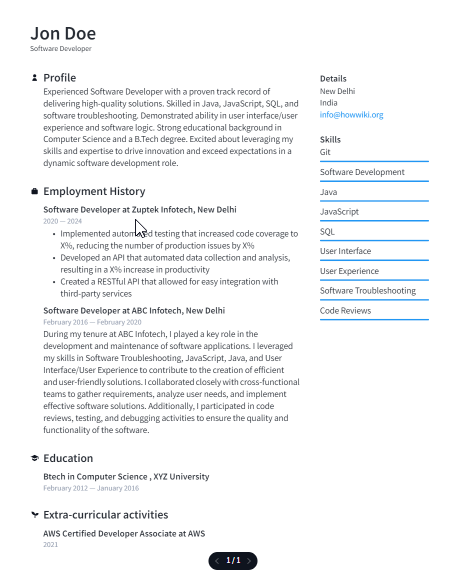A strong CV is your gateway to success in the job market, as it’s the first impression employers will have of you—so it needs to stand out. Crafting a CV that grabs the attention of recruiters and employers has become increasingly challenging, especially with paid professionals offering CV writing services. However, it’s still crucial to learn how to write a CV that can help you land your dream job.
The way CVs are evaluated has drastically changed, with many companies now relying on AI-driven software or ATS to scan and shortlist candidates. This shift means your CV has to do more than just look good—it needs to be optimized for readability by both humans and machines. With so much competition, it’s no longer enough to simply list your qualifications. You need to ensure your CV is formatted in a way that makes it easy for these systems to scan for keywords, while still presenting your skills and experiences in an engaging and impressive manner. Balancing this technical aspect with a professional, eye-catching design is key to standing out in today’s job market.
Now, the question is How to write one? Before moving on to that there are few perquisites for writing a Professional CV.
What research needs to be done before you start writing your CV?
Before writing a CV, thorough research is essential to ensure it aligns with the expectations of potential employers. Start by reviewing job descriptions in your desired industry to understand the skills, qualifications, and experiences commonly sought after. Focus on identifying hard skills, such as technical abilities, certifications, and industry-specific knowledge, that frequently appear in job listings. These should be prioritized in your CV to make it more relevant. While soft skills like communication and teamwork are important, they are often secondary to the technical competencies needed for the role. By conducting this research, you’ll gain insight into the exact qualities employers are looking for, allowing you to tailor your CV accordingly. This preparation not only helps you stand out but also makes the writing process easier, as you’ll have a clear roadmap of what to include to match the requirements of your target jobs.
How to write a Professional CV?
Once you’ve outlined the key elements, it’s time to focus on structuring and formatting your CV. While the content remains vital, the way you organize and present it can make or break your chances of getting noticed.
How to structure your CV?
The structure of a CV has remained quite traditional. It typically begins with your name and contact details, followed by a strong profile summary that highlights your key attributes. Next, you should list your work experience in reverse chronological order, followed by your qualifications and any projects you’ve completed. Adding a skills section that focuses on job-related abilities can give your CV extra weight, making it stand out to both recruiters and AI-based systems.
In modern CVs, many people also choose to include a professional profile image. If you opt for this, make sure the photo is professional—no casual or informal pictures.
Although this structure is common, you’ll find many templates online with this exact layout. What makes a CV truly stand out, however, is not just the structure but also the formatting.
How to format your CV?
Now that the structure is clear, let’s talk about how to format it to ensure readability and professionalism:
- Use a Clean, Readable Font: Stick to simple fonts like Arial, Calibri, or Times New Roman. Avoid decorative fonts, as they can appear unprofessional and difficult to read. Font size should generally be 11 or 12 for body text and slightly larger (14-16) for headings.
- Stick to a Simple Color Scheme: Use black text on a white background for a clean, professional look. Avoid bright colors or flashy designs, which can distract from the content.
- Keep It Concise: Ideally, your CV should be two pages long. Recruiters may skim through it, so focus on clarity and brevity, highlighting only the most relevant information.
- Use Clear Headings: Organize your CV into sections such as “Work Experience,” “Education,” and “Skills” using bold, clear headings. This structure helps recruiters quickly find the information they need.
- Bullet Points for Easy Reading: Use bullet points to list skills, responsibilities, and achievements. This format makes your CV easier to scan and digest quickly.
- Include Adequate White Space: Don’t overcrowd your CV with text. Proper spacing between sections ensures a visually appealing and easy-to-read document.
By balancing a solid structure with clear, professional formatting, your CV will be well-prepared to make a strong impression.

Now that we have established, the format and structure of CV, it is crucial to understand what to put in it.
How to write a CV profile that will grab the recruiter’s attention?
To write a CV profile that grabs a recruiter’s attention, keep it concise, focused, and impactful. Start with a brief introductory sentence highlighting your professional background and key skills that align with the job you’re applying for. Tailor this section specifically to the role by mentioning industry-specific experience, relevant qualifications, and any standout achievements.
Ensure your profile is between 4-6 lines long, providing a snapshot of your strengths without overwhelming the reader. Use strong, active language to convey your abilities, avoiding overused phrases like “hard-working” or “team player.” Instead, focus on quantifiable skills or accomplishments, such as increasing sales by a certain percentage or leading successful projects.
Mention your career goals in a way that aligns with the company’s needs, showing how you can add value to their team. A well-crafted, tailored profile not only attracts recruiters but also encourages them to read further.
How to detail your work experience and education?
To detail your work experience, list your roles in reverse chronological order, starting with the most recent. Include the job title, company name, and employment dates. Use bullet points to highlight key responsibilities and achievements, focusing on quantifiable results like increasing sales or improving processes. Tailor each point to show how your skills contributed to the organisation’s success.
For education, list your qualifications starting with the highest degree or most recent certification. Include the institution, degree obtained, and graduation date. If you’re a recent graduate or the education is highly relevant, you can add a few bullet points detailing key courses or academic achievements. Keep this section concise and relevant to the job you’re applying for.

How to include your hobbies and interests?
Including hobbies and interests in your CV is optional, but they can add value if they relate to the job or demonstrate unique skills. Focus on interests that show your passion for the industry or transferable skills, like leadership, teamwork, or creativity. For example, if you’re applying for a writing role, mentioning a personal blog can highlight relevant skills. Avoid generic hobbies like “watching movies” or “eating out,” as they don’t add much value. You can also include notable achievements, such as running a marathon or volunteering, which demonstrate dedication and initiative. Keep this section brief and relevant.
A well-written, polished CV can be the key to unlocking high-paying job opportunities. By conducting proper research, focusing on the right skills, and formatting your CV to look professional and organized, you’re setting yourself up for success. However, if you still find it tough, go for professional CV writing services. You can find plenty of them on sites like, Fiverr.
FAQs
Ideally, a CV should be two pages long. It should be concise and focused on relevant information to keep the reader engaged.
Generally, it’s not necessary or recommended unless specifically requested. Focus on your skills and experiences rather than your personal appearance to maintain professionalism.



GIPHY App Key not set. Please check settings